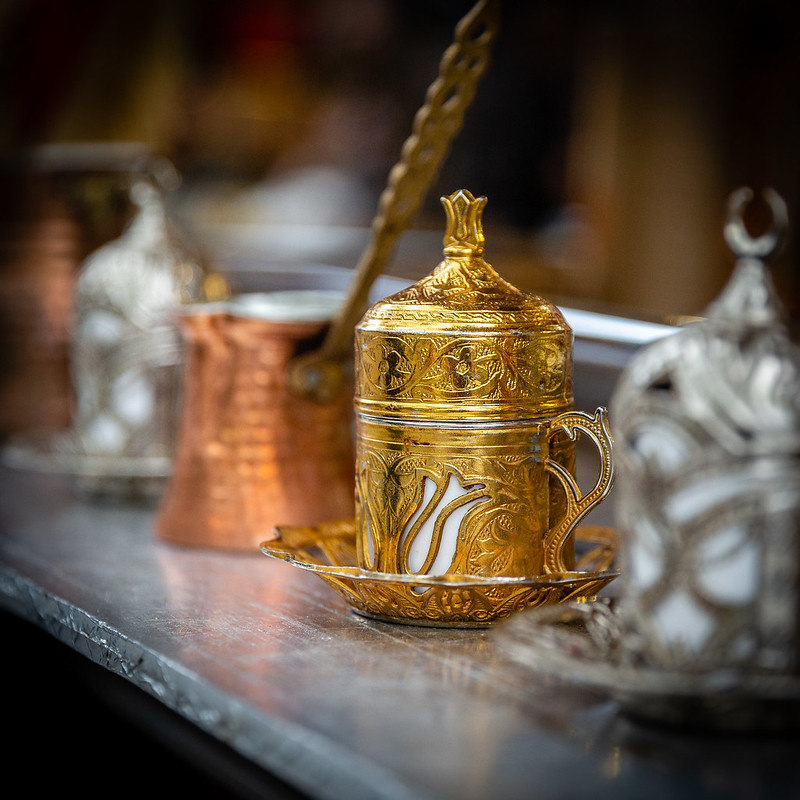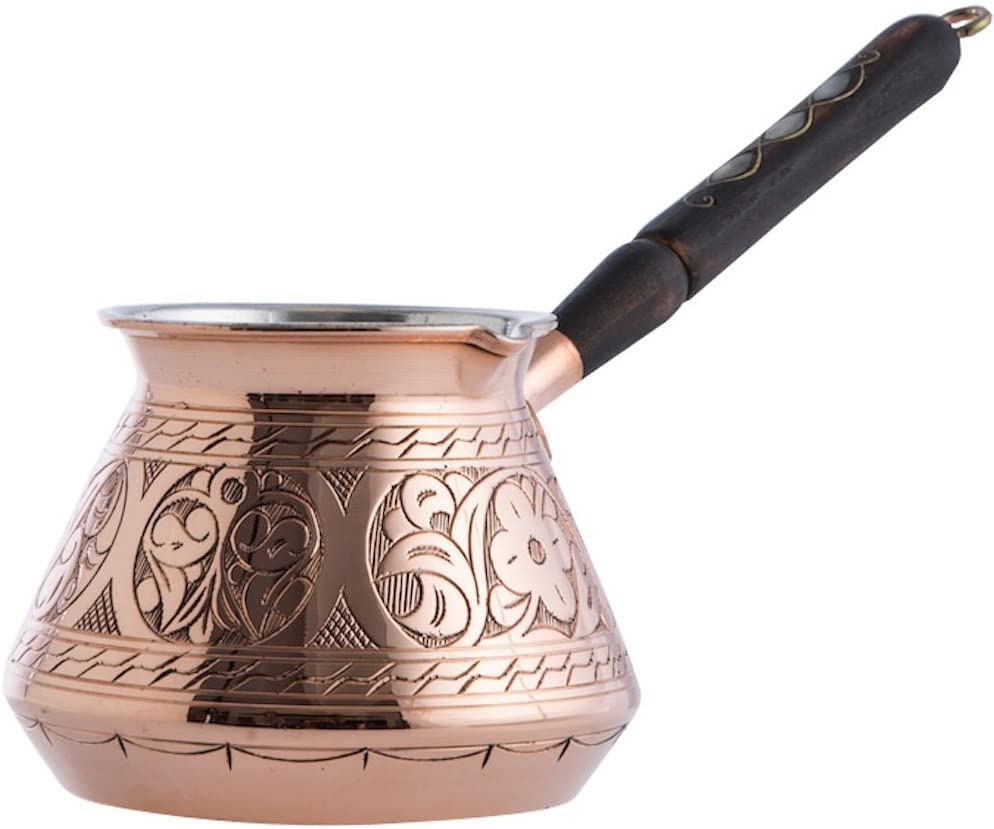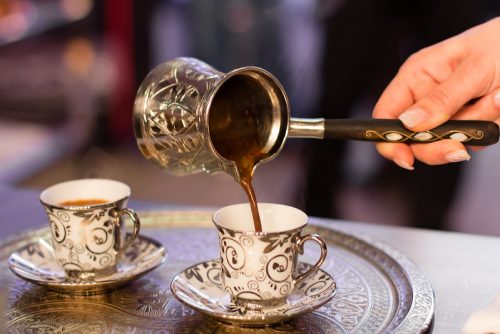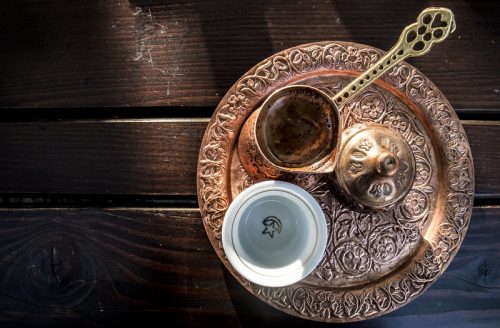Learn How To Make A Traditional Turkish Coffee

Turkish coffee is the name given to the traditional coffee made in Turkey, and which originated in what centuries ago was the Ottoman Empire. The core of that empire was what is today Turkey. The name stuck to the way the local population made coffee then and now.
But Turkish coffee isn’t just “Turkish”. Today in Turkey it’s more properly called “Arabic coffee”. It was diffused in the vast area of the Arab world and not just within the modern borders of the Turkish republic.
Origin
It’s one of the oldest ways to prepare coffee, dating to the 16th century. Back then the coffee was all roasted and harvested in Yemen. Arab merchants then expanded the tradition of drinking coffee in the Muslim world.
The Ottoman Empire included Yemen and the new black beverage started to be known in all the corners of the empire, from Morocco to Iraq and north up to the Balkans. Which, unsurprisingly, is the area in which still today Turkish coffee, or variations of it, are still prepared and drunken.
It is a strong, spicy, and flavorful type of coffee, often connected with a specific ritual that is a sign of hospitality and companionship. A session of making Turkish coffee is held for important guests and before discussing serious matters but not exclusively.
Turkish coffee is also made to welcome beloved friends and had in coffeehouses as a way to have a break from work. It is as much a way to prepare coffee as a cultural tradition.
How To Make
Outside of the area where Turkish coffee is drunk daily, its recipe has become an alternative brewing method for coffee lovers all around the world.
The ritualistic preparation held for important events and guests is rarely followed. But for Turkish communities or Arab-inspired restaurants, but the taste is identical.
Given the diffusion of Turkish coffee, spanning many countries and cultures, the ways to make the beverage are many. We are going to give the most common recipe. A basic one from which you can branch out, knowing that the most important thing is the brewer.
To make a proper Turkish coffee you need a metal pot, called “cezve” in Turkey and “ibrik” elsewhere. It is usually a small pot but very ornate. Cezve for special occasions is true pieces of art and as much part of the coffee-making ritual as any other component.

Don’t worry if you don’t have one yet: it is commonly found in ethnic stores, nowadays, in various sizes. You can do without one and use any metal pot you may have at home.
Make sure to choose one that is not large and whose opening is narrow, as it will help the creation of foam while brewing.
Once you have your cezve or similar, you will need a few more ingredients, namely:
- A grinder
- A slim spoon
- A Turkish-type coffee beans
- Sugar
And that’s about it. What’s important for proper Turkish coffee is the type of beans. You can go with Arabica or Robusta, but Turkish coffee is strong and very aromatic, so choose coffee beans that meet these two criteria. A medium/dark roast is preferred, but not extremely dark as it may end up being too bitter.
Once you have all the tools and ingredients, you can start making a Turkish coffee. Without going into the ritualistic aspects of the brewing, the simplest recipe is:
- Add how much water you want in the pot
- Set the heat to the medium and let the water heat up
- Add 1-2 teaspoons of your finely ground coffee. Do not stir
- Add sugar to taste, and don’t stir it either
- Once the coffee begins to sink and the sugar naturally starts to dissolve, lower the heat and stir until some foam begins to form
- Remove from the heat but keep stirring. You don’t want the coffee to boil but just get close to the point of boiling, so it will create a nice foam on top
- Put back and remove the coffee from the heat, alternatively, in order to not let it boil but keep it very hot. If the foam starts to rise, remove the pot from the heat until it drops, and then put it back on. This operation can be repeated multiple times (ideally at least two)
- Serve immediately.
Turkish coffee is to be drunken quite hot. It can be reheated a couple of times but it will progressively become more bitter as it will be over-extracted.
Try to have it with a nice foam on top. Never allow it to reach the boiling point. With an adequate amount of sugar to contrast with the darkest flavors of the strong coffee and hot enough to warm you up.
That’s the basic recipe to make a proper Turkish coffee. Infinite variations exist, with different types of sugar. Some with cardamom or cinnamon added to the mixture, with or without any foam, with darker roasts, and so on.
How To Serve
Once you have made your first cup of Turkish coffee, your task isn’t complete.

A proper way to drink it is as important as making it. Turkish coffee is always accompanied by a glass of water. This is to wash the palate and either prepare it for the coffee or remove any aftertaste of it, usually because it is too bitter.
On special occasions, the person who made the coffee will serve it, multiple times if needed, by moving from guest to guest and filling up their cups.
Sweets like candies can be served as well, especially if the Turkish coffee was made with little sugar in it.
Drinking Technique
Do not drink the coffee until the coffee grounds have settled on the bottom of the cezve. That will take about one minute. Sip the Turkish coffee very slowly. It is a ritual after all and not one that needs to end soon.
Think, chat with your friends, or simply enjoy the coffee while sipping it. Do not worry if some coffee grounds end up in your mouth, it is normal. Just stop before reaching the mound of coffee at the bottom of your cup.
In Conclusion
Regardless of the ritual attached to it, Turkish coffee is a strong experience. Try it with half a spoon of cardamom for a truly exotic taste. Experiment with medium and medium-dark roasts to have a coffee that has a nice body is intense and quite bitter but not overwhelmingly so.

Reheating it in the pot will make it more bitter so try to use coffee beans that aren’t super-bitter of their own already. Making Turkish coffee doesn’t take much longer than brewing with a French press or a Moka pot and is a good alternative to both brewing systems.
Turkish coffee is intense and provides a great contrast between the coffee and the added sugar or spices. It is a new experience for many, and once properly mastered will impress your guests with a brewing ritual that goes back centuries.
Being part, even for a few minutes, of such a long tradition can make anyone feel like a coffee master.